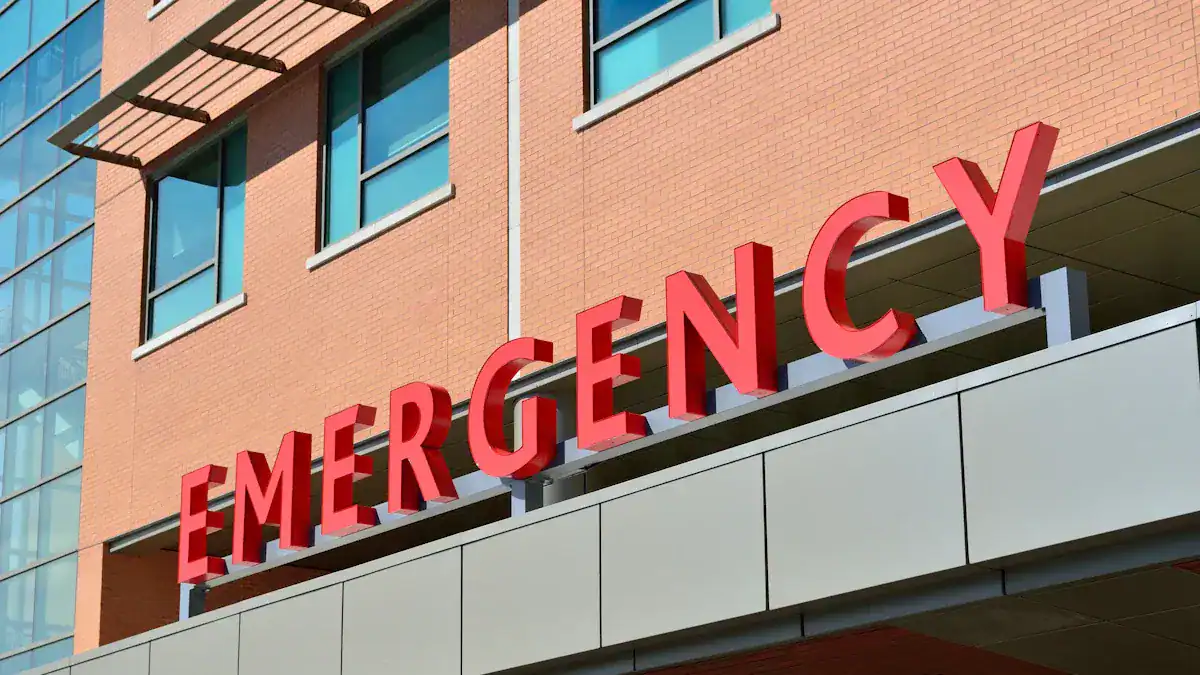
When does sharp abdominal pain demand your attention? You must understand when to seek help. Severe abdominal pain is never normal. Acute abdominal pain accounts for a significant portion of Emergency Department visits each year. This highlights its common nature as an urgent health need.
Sometimes, you need an emergency room for your pain. Other times, urgent care or your primary care doctor can address your abdominal pain. Always seek urgent medical attention for new-onset abdominal pain or any persistent stomach pain. Do not ignore these symptoms. This guides you to the right urgent care. An emergency situation requires immediate urgent care.
Key Takeaways
Sharp abdominal pain is never normal. It often means a serious health problem. You should always get medical help for new or lasting stomach pain.
Go to the emergency room for sudden, very bad pain. Also go if you have a high fever, bloody vomit, or cannot pass gas or stool. These are signs of a serious emergency.
You can visit urgent care for pain that is not as severe. This includes moderate pain that lasts, mild nausea, or flare-ups of known stomach problems.
Doctors will ask questions and do a physical exam. They may order tests like blood work or scans. This helps them find the cause of your pain and give you the right treatment.
Urgent Causes of Sharp Abdominal Pain

Sharp abdominal pain is never normal. It often signals a serious underlying condition. You need to understand these urgent causes. Conditions like appendicitis, ectopic pregnancy, ruptured abdominal aneurysm, bowel obstruction, severe gallstones, acute pancreatitis, and kidney stones all require prompt medical attention. These conditions can quickly become life-threatening if you delay treatment.
Appendicitis Signs
Appendicitis is an inflammation of your appendix. It causes sharp abdominal pain. This pain often starts around your belly button. It then moves to your lower right abdomen. The pain becomes sharper and more localized there. You might also feel nausea and lose your appetite. The pain tends to get worse over time. It differs from typical stomach pain.
Key signs of appendicitis that warrant medical attention include:
- Pain that starts near the belly button and moves to the lower right side of your stomach. This pain often feels sharp, crampy, or dull. It worsens over time.
- Fever.
- Nausea or vomiting.
- Loss of appetite.
- Swelling in your abdomen.
- Trouble passing gas.
- Pain when you move, cough, or sneeze.
You may also experience a fever, feeling generally unwell, or a swollen belly. Sometimes, you have urinary symptoms like frequent urination. Bowel paralysis can lead to constipation or an inability to pass gas. Diarrhea can also occur. If you suspect appendicitis, you need urgent medical attention. It often requires urgent surgical removal.
Ectopic Pregnancy Risks
An ectopic pregnancy is a serious, life-threatening condition. It occurs when a fertilized egg grows outside your uterus, usually in a fallopian tube. Your fallopian tubes are not flexible.
They cannot stretch like your uterus. As the pregnancy develops, the tube can burst. This causes severe and potentially life-threatening internal bleeding. You will feel sharp abdominal pain. This pain is often on one side.
A ruptured fallopian tube is a life-threatening emergency. It requires immediate surgery.
The cornual region of your uterus is also not designed for a growing embryo. If an ectopic pregnancy occurs there, you will experience acute and sharp pain. This unsuitable environment for growth leads to intense pain. If you are pregnant and experience sharp abdominal pain, seek immediate treatment.
Ruptured Aneurysm Dangers
A ruptured abdominal aneurysm is extremely dangerous. It is a life-threatening condition. This happens when a weak spot in your aorta, the body’s main artery, bursts. It causes massive internal bleeding. You will feel sudden, severe abdominal pain. This pain can spread to your back, groin, or legs.
A ruptured abdominal aortic aneurysm is fatal about 80% of the time. Many people die before reaching the hospital. You could bleed out your entire blood volume in one minute.
This condition requires immediate emergency medical care. Do not delay seeking help if you experience these symptoms.
Bowel Obstruction Indicators
A bowel obstruction means something blocks your small or large intestine. This blockage prevents food and waste from passing through. You will experience sharp, cramp-like abdominal pain. This pain can also be a persistent, dull ache. It often comes with nausea, vomiting, and bloating. You may also be unable to pass gas or stool.
Abdominal pain from bowel obstruction often manifests as sharp, stabbing pains or intense cramping.
A complete bowel obstruction is a medical emergency. It presents with a sudden onset of severe abdominal pain.
In children, severe abdominal pain with inconsolable crying and drawing knees to the chest can indicate intussusception, a type of bowel obstruction. This condition needs urgent medical attention to prevent serious complications.
Severe Gallstones and Pancreatitis
Severe gallstones can cause intense abdominal pain. Gallstones are hardened deposits of digestive fluid. They form in your gallbladder. When a gallstone blocks a bile duct, you feel severe, constant pain. This pain is often in your upper right abdomen. It can happen after meals or at night. You may also feel nausea.
Acute pancreatitis is inflammation of your pancreas. It causes severe abdominal pain. This pain often starts in your upper abdomen and can radiate to your back. It may worsen after eating. You might also experience nausea, vomiting, and a tender abdomen. Both severe gallstones and acute pancreatitis require urgent medical evaluation.
Kidney Stones Pain
Kidney stones are hard deposits of minerals and salts. They form inside your kidneys. When a stone moves into your ureter, it causes excruciating pain. This pain is known as renal colic. It is one of the most severe types of pain. The pain often starts suddenly. It is typically felt along your side and back, below your ribs. The pain can move to your belly and groin area.
Kidney stone pain comes in waves. Each wave may last a few minutes. It then disappears and returns. This happens as your ureter contracts to push the stone out.
You may also experience frequent or painful urination, blood in your urine, nausea, and vomiting. The pain can be intermittent or ongoing. It can be stabbing or throbbing. If you have these symptoms, you need urgent medical attention.
ER for Severe Abdominal Pain

You need to know when your abdominal pain requires an immediate trip to the emergency room. Some symptoms signal a critical situation. Do not delay seeking help for these signs. You should go to the emergency room if you experience sudden, severe abdominal pain.
This is especially true if the pain rates 9 or 10 out of 10. Pain after an accident or injury also needs urgent attention. If your abdominal pain comes with chest, neck, or shoulder pain, you need immediate medical care. Persistent pain in your lower right abdomen, like with appendicitis, also warrants an emergency room visit.
Sudden, Intense Pain
Sudden, intense abdominal pain is a clear sign you need emergency care. This pain often makes it hard for you to move, eat, or drink. It comes on quickly and feels very strong. You might rate this pain as a 9 or 10 on a scale of 1 to 10.
Even without other severe symptoms, this level of pain means you need immediate medical attention. Do not try to manage this kind of pain at home.
Pain with High Fever or Chills
A high fever combined with abdominal pain is a serious concern. For adults, a temperature of 103°F (39.4°C) or higher, especially with severe abdominal pain, means you need to go to the emergency room.
For children, a fever of 100.4°F (38°C) or higher along with abdominal pain also requires an emergency room visit. Any child with a fever of 105°F or higher needs immediate medical care, regardless of other symptoms. Chills often come with a high fever. They indicate your body is fighting a serious infection. These severe symptoms need urgent evaluation.
Bloody Stools or Vomit
Seeing blood in your vomit or stools is always an emergency. If you vomit blood, it might look red or have dark streaks. Sometimes, vomit looks like coffee grounds. This indicates serious bleeding.
If your stools are bloody or tarry black, this also points to internal bleeding. You might feel dizzy or lightheaded along with these symptoms. These are critical signs. You need immediate medical attention for any blood in your vomit or stools.
Abdominal Rigidity or Swelling
Abdominal rigidity means your belly muscles feel stiff. They tighten involuntarily when someone touches your abdomen. This is your body’s way of protecting itself from pain. This “guarding” is different from just flexing your muscles. It suggests a serious problem inside your abdomen.
Your abdomen might also become very hard or expand quickly. This increased abdominal girth, or a distended abdomen, is another sign of a potential medical emergency. These symptoms often come with tenderness, nausea, and vomiting.
Pain After Trauma
If you have abdominal pain after an accident or injury, you need immediate medical attention. This includes severe pain from falls, car accidents, or direct blows to your stomach. Look for open wounds, objects stuck in your abdomen, or severe bleeding. Your abdomen might feel tender, swollen, or rigid. You might also see bruising on your stomach.
Nausea or vomiting, possibly with blood, can also occur. Signs of shock, like dizziness or fainting, also mean you need urgent care. These situations can lead to internal bleeding or organ damage.
Inability to Pass Gas or Stool
If you cannot pass gas or have a bowel movement for a long time, and you also have severe abdominal pain, you need to go to the emergency room. This can indicate a bowel obstruction.
A bowel obstruction is a medical emergency. It means something is blocking your intestines. You might also experience significant bloating. Do not wait for these symptoms to get worse. Seek urgent medical care.
When Urgent Care or PCP is Appropriate
Sometimes, your abdominal pain needs medical attention but not an emergency room visit. You can choose urgent care or your primary care provider (PCP) for less severe but still concerning situations.
Dr. Shah suggests contacting your PCP for new-onset abdominal pain, diarrhea, or constipation. If your PCP is unavailable, urgent care is a good choice. You should always see a doctor in person for new or severe abdominal pain.
Moderate, Persistent Pain
You might have moderate abdominal pain that does not go away. This type of pain can indicate a more serious issue.
It needs a doctor’s attention. If over-the-counter medicine does not relieve your pain, seek urgent medical help. Do not hesitate to visit urgent care if your abdominal pain is persistent or comes with other concerning symptoms. Trust your instincts if you are unsure about your sharp abdominal pain.
Pain with Mild Nausea
If you have abdominal pain with mild nausea, urgent care can often help. This includes mild stomach upset that home care has not improved. You might also have mild diarrhea or vomiting without dehydration. These symptoms are usually manageable with oral fluids. Urgent care centers can assess these conditions.
Known Conditions with Flare-ups
You may have a chronic condition that causes abdominal pain flare-ups. Urgent care can manage these situations.
Urgent care is suitable for flare-ups of conditions like:
- Crohn’s disease
- Ulcerative colitis
- Persistent heartburn or acid reflux (if home remedies fail)
- Gastroenteritis (stomach cramps, nausea, diarrhea)
- Constipation
- Gastritis
These flare-ups need medical evaluation. They do not always require an ER.
General Advice for Less Severe Pain
For less severe abdominal pain, you can try home management first. This includes intestinal or menstrual cramps.
Rest.
Apply heat to your abdomen.
Stay hydrated.
Give your digestive system a rest with broths and teas for a day.
Herbal teas like peppermint, licorice, and ginger can soothe your stomach pain.
Adjust your diet long-term.
You can also eat smaller, more frequent meals. Avoid late-night eating. Reduce stress to help your gut.
Medical Evaluation for Abdominal Pain
When you experience abdominal pain, you must seek medical help. Do not try to diagnose yourself. A medical evaluation helps find the exact cause of your pain. This process involves several steps.
Initial Assessment and Questions
Your doctor starts by asking many questions. They want to understand your abdominal pain fully. You will describe the characteristics of your pain. This includes when it started, how it feels (sharp, dull, crampy), and if it moves. You will also discuss what makes the pain better or worse.
Doctors often use the PQRST method to assess your pain. They ask about other symptoms you have, like fever, nausea, or changes in bowel habits. Your medical history, current medications, and family history are also important. For women, they will ask about your menstrual and sexual history. This helps rule out specific causes like ectopic pregnancy.
Physical Examination Steps
After the questions, your doctor performs a physical exam. This exam has four main parts. First, they inspect your abdomen. They look for swelling or unusual movements.
Next, they auscultate. This means they listen to your abdomen with a stethoscope. They check for bowel sounds. Then, they palpate. They gently press on different areas of your abdomen. This helps them find tender spots or masses. They start away from your most painful area.
Finally, they percuss. They tap on your abdomen to check for fluid or air. Specific tests, like Murphy’s sign for gallbladder issues or Psoas sign for appendicitis, may also be part of the exam. For lower abdominal pain, you might need a rectal or pelvic exam.
Common Diagnostic Tests
If the cause of your abdominal pain is not clear, your doctor may order tests. These tests help identify the problem.
Lab Tests: You might have blood tests to check for infection or organ function. Urine tests look for urinary tract issues. Stool tests can find infections or blood. For women, a pregnancy test is common.
Imaging Tests: These show pictures inside your body. An ultrasound can view organs like your gallbladder or kidneys. X-rays can show blockages or gas. CT scans give detailed images of your abdominal organs.
Endoscopic Procedures: Sometimes, doctors use a camera to look inside. An upper GI endoscopy views your esophagus and stomach. A colonoscopy looks at your colon.
Never ignore sharp abdominal pain. It signals a serious issue. You must recognize key red flag symptoms demanding immediate emergency attention. These include sudden, severe pain, vomiting, high fever, or bloody stools. This severe abdominal pain needs urgent evaluation.
Timely medical evaluation is crucial for accurate diagnosis and effective treatment of your abdominal pain. Trust your instincts. Get professional help when in doubt about your abdominal pain. Urgent care is always available for your pain. Do not delay seeking urgent medical help. Your health is important. For any concerning abdominal pain, visit urgent care.




